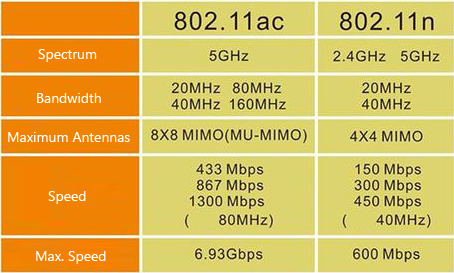IEEE 802.11 ac is a new wireless network standard in IEEE 802.11 family. This Standard is also called as Gigabyte wireless LAN which is the latest version of Wi-Fi standards. The IEEE 802.11ac has been proposed to enhance the throughput of IEEE 802.11n standard beyond Gigabit per second & Client capability which are increasingly demanded by Mobile Users. Even when the network is not loaded fully, the user can see the files download and gmail sync with low GB speed.
The purpose of the 802.11ac amendment is to improve the Wi-Fi user experience by providing significantly higher throughput for existing application areas, and to enable new market segments for operation below 6 GHz including distribution of multiple data streams.

Key fetures of 802.11ac standard:
Frequency band of 5GHz – The 802.11n operates in both 2.5GHz and 5GHz RF bands Whereas 802.11ac operates only in 5GHz RF bands to restrict usage in this band is mainly driven by the wider channel bandwidth requirements for 802.11ac.
Modulation – 802.11ac uses Orthogonal Frequency-Division Multiplexing (OFDM) to modulate bits for transmission. While the modulation method is the same as that used in 802.11n, 802.11ac optionally allows the use of 256 QAM. This increases the number of bits per sub-carrier from 6 to 8, resulting in up to a 33% increase in PHY data rate.
Backwards Compatibility - 802.11ac provides backwards compatibility with 802.11a and 802.11n devices operating in the 5 GHz band. This means that 802.11ac interworks with devices supporting 802.11a and 802.11n technologies & 802.11ac frame structures can accommodate transmission with 802.11a and 802.11n devices .
More MIMO spatial streams - Support for up to eight spatial streams (four in 802.11n)
Speed: The Minimum speed of 802.11ac 1300 Mbps and the Maximum speed of 802.11ac standard is like 6.93 Gbps. The maximum speed is increased compared to 802.11n IEEE standard
Disadvantages of 802.11ac standard:
More expensive
2.4 GHz band is not supported.
Speed and Performance of device can vary for different devices
As a conclusion IEEE 802.11ac was developed to enable data transfer with a minimum speed of arround 1Gbps and a maximum speed of around 7Gbps.